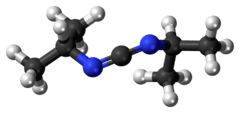N,N'-Diisopropylcarbodiimide
N,N′-Diisopropylcarbodiimide is a carbodiimide used in peptide synthesis. As a liquid, it is easier to handle than the commonly used N,N′-dicyclohexylcarbodiimide, a waxy solid. In addition, N,N′-diisopropylurea, the byproduct of its use in many chemical reactions, is soluble in most organic solvents, a property that facilitates work-up.
_200.svg.png) | |
 | |
| Names | |
|---|---|
| Preferred IUPAC name
N,N'-Di(propan-2-yl)methanediimine | |
| Other names
Diisopropylmethanediimine | |
| Identifiers | |
3D model (JSmol) |
|
| Abbreviations | DIC, DIPC |
| 878281 | |
| ChEBI | |
| ChEMBL | |
| ChemSpider | |
| ECHA InfoCard | 100.010.677 |
| EC Number |
|
| 101400 | |
PubChem CID |
|
| UNII | |
CompTox Dashboard (EPA) |
|
| |
| |
| Properties | |
| C7H14N2 | |
| Molar mass | 126.203 g·mol−1 |
| Appearance | Liquid |
| Density | 0.806 g/mL |
| Boiling point | 145 to 148 °C (293 to 298 °F; 418 to 421 K) |
| Hazards | |
| Safety data sheet | External MSDS |
| GHS pictograms |      |
| GHS Signal word | Danger |
GHS hazard statements |
H226, H315, H317, H318, H330, H334 |
| P210, P233, P240, P241, P242, P243, P260, P261, P264, P271, P272, P280, P284, P285, P302+352, P303+361+353, P304+340, P304+341, P305+351+338, P310, P312, P320, P321, P332+313, P333+313 | |
Except where otherwise noted, data are given for materials in their standard state (at 25 °C [77 °F], 100 kPa). | |
| Infobox references | |
Further reading
- Angell, Y (1994). "Comparative studies of the coupling of N-methylated, sterically hindered amino acids during solid-phase peptide synthesis". Tetrahedron Lett. 35 (33): 5981. doi:10.1016/0040-4039(94)88054-9.
- Izdebski, JAN; Orlowska, Alicja; Anulewicz, Romana; Witkowska, EWA; Fiertek, Dariusz (1994). "Reinvestigation of the reactions of carbodiimides with alkoxycarbonylamino acid symmetrical anhydrides : Isolation of two N-acylureas". Int. J. Pept. Protein Res. 43 (2): 184. doi:10.1111/j.1399-3011.1994.tb00521.x.
gollark: You can't easily use v4 by hand.
gollark: What do you want to do with it?
gollark: For reasons.
gollark: We skipped 2 and 3.
gollark: v4, generally.
This article is issued from Wikipedia. The text is licensed under Creative Commons - Attribution - Sharealike. Additional terms may apply for the media files.